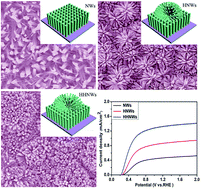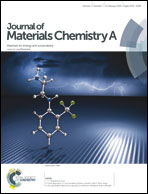Synthesis of three-dimensional hyperbranched TiO2 nanowire arrays with significantly enhanced photoelectrochemical hydrogen production†
Abstract
The three-dimensional (3D) hierarchical nanostructure is one of the promising candidates for high performance photoelectrochemical (PEC) water splitting electrodes due to the reduced carrier diffusion distance, improved light absorption efficiency and charge collection efficiency. Here, by growing omnidirectional, densely packed branches on TiO2 nanowires, we demonstrated a 3D hyperbranched hierarchical TiO2 nanowire (HHNW) architecture that could significantly enhance the performance of PEC water splitting. Under a solar simulator with chopped AM 1.5G light of 100 mW cm−2 intensity, the HHNW electrode yielded a photocurrent density of 1.21 mA cm−2 at 1.23 V with respect to the reversible hydrogen electrode (RHE), which was about four times higher than that of TiO2 nanowires (NWs) (0.34 mA cm−2). The highest incident photon-to-current conversion efficiency (IPCE) obtained from our HHNWs was 77% at 365–425 nm. This greatly improved PEC performance can be attributed to the improved light absorption efficiency and the increased contact surface areas at the TiO2/electrolyte interface.


 Please wait while we load your content...
Please wait while we load your content...